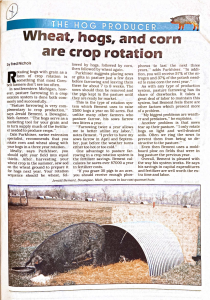Farmers love to kick tires, share stories, and due to their curious nature, are always looking to pick up tips for their trade. It’s no wonder the agricultural industry is rife with trade shows. Perhaps the most influential show is Commodity Classic, where the National Corn Growers Association, American Soybean Association, National Wheat Growers Association and National Sorghum Producers – along with the Association of Equipment Manufacturers – converge to offer a fun and educational experience for their members. #Classic24 kicks off Thursday in Houston and is expected to draw around 10,000 farmers and industry professionals. But the show’s impact goes well beyond sheer numbers of attendees. It’s a proverbial “who’s who” of farming, made up of yield contest winners, elected delegates to state and national associations and some of the most innovative growers in the land. As is customary, US Secretary of Agriculture Tom Vilsack will be on hand. On average, farmer attendees operate 3,200 acres, earn $3.5 million in gross income and annually purchase nearly $650,000 in fertilizer, $486,000 in seed and crop protection products and $958,000 in equipment. Among attendees, 72% say Commodity Classic is the most important event they attend all year. Huma will be among the exhibitors, launching a new booth experience for our new brand, located along the show’s main thoroughfare.
Ethanol is essentially tied with animal feed as the largest market for US-grown corn, now serving as the destination for 38% of America’s most widely grown crop. Ethanol is included in 97% of all gas sold from sea to shining sea. With that type of saturation, the only way to grow the domestic volume is by adding a higher content of the corn-based additive into fuel. That’s the concept behind E15 – also known as Unleaded 88, due to its octane level – a blend that includes 15% ethanol vs. the standard 10% blend. GHG-reducing E15 is a proven fuel source that’s logged over 90 billion miles and can be used in virtually all vehicles 2001 or newer. If just 1/3 of all US gas pumps were converted to E15, that would offset all Russian oil imports. Plus, E15 saves motorists 10-15 cents per gallon at the pump. So E15 would seem like a no-brainer, right? Not according to the EPA. A single, decade’s old study found that E15 increases pollutants during the summer months, thus restricting sales of the fuel to just under nine months. That study has since been refuted, with evidence pointing to E15 decreasing tailpipe emissions all year. Seasonal use restrictions are anything but convenient for the retailers who sell fuel, which has hampered adoption. Last week, the EPA granted year-round sale of E15, but not starting until 2025. This unnecessary delay stoked the ire of midwestern politicians. Farm-girl-turned-governor Kim Reynolds of Iowa is pushing for a federal waiver that will allow E15 to be sold in the Hawkeye State this summer. Seven other governors (three Dem, four Rep) have joined Reynolds in petitioning the EPA for year-round access. Ethanol is one of the very few issues that fosters bi-partisan support. It’s largely a regional issue with legislators of corn-producing areas working as, well, united states.
Attention is mounting over the use of livestock in a crop rotation system. It’s a key topic at seemingly every regen ag related event, advocated by many prominent voices. Yet the practice certainly isn’t new. Rotational grazing has long been a pillar of regen ag. Now many are advocating for raising beef along with corn, soybeans, wheat or any other crop as part of a rotation. Managed correctly, cattle can greatly improve soil health via aeration, nutrient cycling, and adding microbial diversity. But the livestock utilized in such a system isn’t exclusively reserved for bovine. Four decades ago, a young writer at Prairie Farmer magazine made known the practice of using swine within a crop rotation, citing a significant reduction in synthetic fertilizer and rotational diversity as benefits. Wonder what ever happened to that writer?

Related Posts

This Week in Ag #11
You shouldn’t judge a book by its cover, but you can judge seed products by their bag covers. There’s lots of telling information on them. Just look at this bag of seeds going on my farm. The bag itself prominently features the brand name and logo (AgriGold), type of product (corn), the actual product name (A647-79VT2PRO) and

This Week in Ag #15
“Your rows sure are straight.” Those may have been the most pride-filling words I ever heard. They were first spoken to me by one of my landlords, Orville Larson, the spring after my dad passed away and all farming operations fell entirely on me. Orville made a habit of driving out to his farm to see

This Week in Ag #42
What’s fueling regenerative agriculture? Sustainability, climate concerns, ESG-driven investors, soil health and heightened crop input costs are all major contributors. Another may be the shift in demographics. Millennials (born 1981-1996) recently passed baby boomers as the USAs most populous generation. And more than half of the US population is now comprised of millennials or younger. With a shift in population, and shift in culture, comes a shift in buying patterns.

